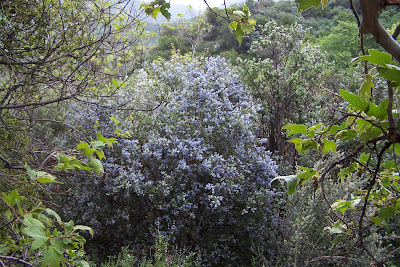On April 11th, I visited Quail Springs permaculture project at the edge of the Cuyama Valley in eastern Ventura County. I'll publish a portfolio of pictures and podcasts for you ASAP and share the good news about building sustainable community in a semi arid region. In the meantime I've got to share some scenery from the trip and some bad news about organic farming run-amok in an out of the way corner of the county.
You Can't Get There From Here
There is no such thing as driving a straight line from the grassy foothills and coastal plain where I live to the semi arid high desert of the inland part of the county. The road runs south and the east through coastal mountians...
I drove south on US Highway 101, to California 150 East to Ojai and then on to California Highway 33.
The route winds through gentrified (and eternally cosmic) Ojai and then runs north. The road runs through tunnels blasted through solid rock (a depression era road project) into Wheeler Gorge.
I snapped these pictures on an overcast Sunday morning where coastal fog was meeting overcast skies and a Pacific Storm on the way in from the north.
The hills were in bloom with spring wildflowers and shrubs like the pale blue ceanothus. I get a little goofy about this stuff but I've spent a lot of time on hiking trails in the mountains.
I had to stop the car several times to snap photos of our wild lupines, growing out the side of bare dirt hills and chaparral at about 2500 feet. It seems so improbable and I wanted to share this picture with my PEI friends, for whom the big friendly and colorful lupine is a summer visitor and even a sometime pest.
It's Spring and the Topsoil is in the Air!
Life is both more fragile and more committed the further east you go from here. On the other side of the next mountain range or two you arrive in the Mojave Desert which stretches all the way to the Colorado River and beyond into Arizona. Here in the Cuyama River Valley, years of farming, cattle grazing and irrigation in this semi arid region (figure less than 12 inches of annual rain fall) has taken their toll. And that leads to the title of this post. In the picture above the roadside flowers pop out of a backdrop of soil blowing in the wind.
This is the view from the highway of land tilled for spring planting. The ground is very sandy and there is hardly any kind of organic matter in it. Low moisture/dry air makes breaking down organic cover or natural soil building take too long for these farmers. So they essentially plant in the dust and irrigate using energy to pump water up from the fossil riverbed beneath valley floor. Overdrafitng this water supply could eventually end all farming in the valley.
Farming here is being done on leased ground and much of the production here is now certified organic. Lot's of those cute little "baby" carrots (which aren't really baby carrots) come from here. And lot's of them carry the USDA organic label.
This picture really tells the whole story of Organic Farming From Hell. The wind is blowing at about 40 mph. The top soil is literally blowing away and there is no cover visible for miles. The foreground shows tilled soil that looks sterile. And the middle distance shows overhead irrigation using fossil energy to pump water into the wind just about an hour before at least half an inch of rain began to fall. Now I can't say for sure that this field is certified organic, but the point is that a lot of the fields here are and they all look identical. They may be organic but they are certainly not sustainable. Calling conventional ag by any other name doesn't make it better for the land.
I won't mention the name of the largest ag company that's currently leasing and farming the majority of this area. I'm thinking they wouldn't appreciate me showing you how they operate. I'm just pointing to this real world example to let you know that organic is not the ending point it's the beginning point. We have much more work to do to make our agriculture and by extension our communities, sustainable places to live.

























